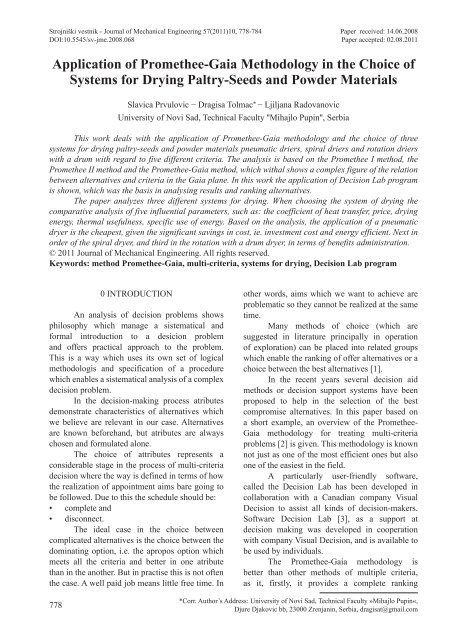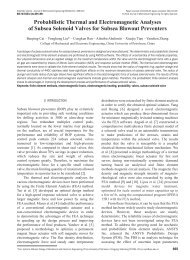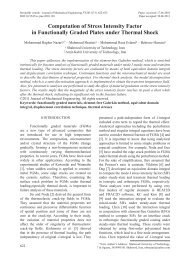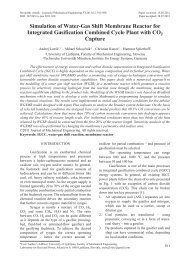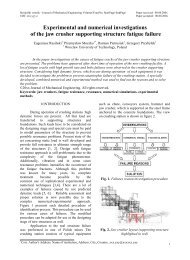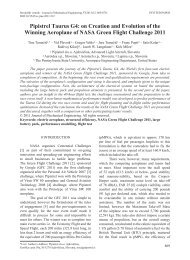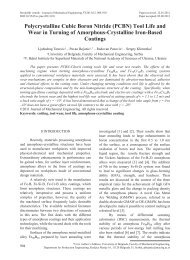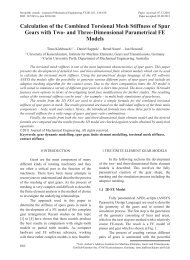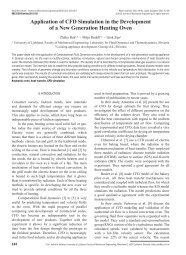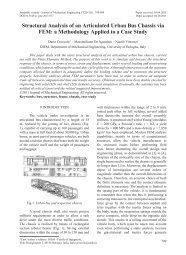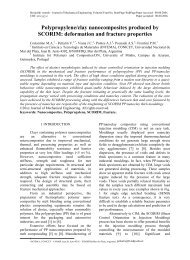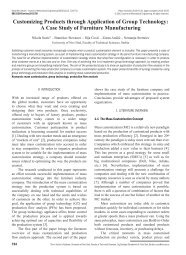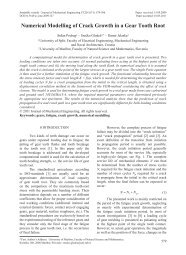Application of Promethee-Gaia Methodology in the Choice of ...
Application of Promethee-Gaia Methodology in the Choice of ...
Application of Promethee-Gaia Methodology in the Choice of ...
You also want an ePaper? Increase the reach of your titles
YUMPU automatically turns print PDFs into web optimized ePapers that Google loves.
Strojniški vestnik - Journal <strong>of</strong> Mechanical Eng<strong>in</strong>eer<strong>in</strong>g 57(2011)10, 778-784 Paper received: 14.06.2008<br />
DOI:10.5545/sv-jme.2008.068 Paper accepted: 02.08.2011<br />
<strong>Application</strong> <strong>of</strong> <strong>Prome<strong>the</strong>e</strong>-<strong>Gaia</strong> <strong>Methodology</strong> <strong>in</strong> <strong>the</strong> <strong>Choice</strong> <strong>of</strong><br />
Systems for Dry<strong>in</strong>g Paltry-Seeds and Powder Materials<br />
Prvulovic, S. − Tolmac, D. − Radovanovic, L.<br />
Slavica Prvulovic − Dragisa Tolmac * − Ljiljana Radovanovic<br />
University <strong>of</strong> Novi Sad, Technical Faculty ''Mihajlo Pup<strong>in</strong>'', Serbia<br />
This work deals with <strong>the</strong> application <strong>of</strong> <strong>Prome<strong>the</strong>e</strong>-<strong>Gaia</strong> methodology and <strong>the</strong> choice <strong>of</strong> three<br />
systems for dry<strong>in</strong>g paltry-seeds and powder materials pneumatic driers, spiral driers and rotation driers<br />
with a drum with regard to five different criteria. The analysis is based on <strong>the</strong> <strong>Prome<strong>the</strong>e</strong> I method, <strong>the</strong><br />
<strong>Prome<strong>the</strong>e</strong> II method and <strong>the</strong> <strong>Prome<strong>the</strong>e</strong>-<strong>Gaia</strong> method, which withal shows a complex figure <strong>of</strong> <strong>the</strong> relation<br />
between alternatives and criteria <strong>in</strong> <strong>the</strong> <strong>Gaia</strong> plane. In this work <strong>the</strong> application <strong>of</strong> Decision Lab program<br />
is shown, which was <strong>the</strong> basis <strong>in</strong> analys<strong>in</strong>g results and rank<strong>in</strong>g alternatives.<br />
The paper analyzes three different systems for dry<strong>in</strong>g. When choos<strong>in</strong>g <strong>the</strong> system <strong>of</strong> dry<strong>in</strong>g <strong>the</strong><br />
comparative analysis <strong>of</strong> five <strong>in</strong>fluential parameters, such as: <strong>the</strong> coefficient <strong>of</strong> heat transfer, price, dry<strong>in</strong>g<br />
energy, <strong>the</strong>rmal usefulness, specific use <strong>of</strong> energy. Based on <strong>the</strong> analysis, <strong>the</strong> application <strong>of</strong> a pneumatic<br />
dryer is <strong>the</strong> cheapest, given <strong>the</strong> significant sav<strong>in</strong>gs <strong>in</strong> cost, ie. <strong>in</strong>vestment cost and energy efficient. Next <strong>in</strong><br />
order <strong>of</strong> <strong>the</strong> spiral dryer, and third <strong>in</strong> <strong>the</strong> rotation with a drum dryer, <strong>in</strong> terms <strong>of</strong> benefits adm<strong>in</strong>istration.<br />
© 2011 Journal <strong>of</strong> Mechanical Eng<strong>in</strong>eer<strong>in</strong>g. All rights reserved.<br />
Keywords: method <strong>Prome<strong>the</strong>e</strong>-<strong>Gaia</strong>, multi-criteria, systems for dry<strong>in</strong>g, Decision Lab program<br />
0 INTRODUCTION<br />
An analysis <strong>of</strong> decision problems shows<br />
philosophy which manage a sistematical and<br />
formal <strong>in</strong>troduction to a desicion problem<br />
and <strong>of</strong>fers practical approach to <strong>the</strong> problem.<br />
This is a way which uses its own set <strong>of</strong> logical<br />
methodologis and specification <strong>of</strong> a procedure<br />
which enables a sistematical analysis <strong>of</strong> a complex<br />
decision problem.<br />
In <strong>the</strong> decision-mak<strong>in</strong>g process atributes<br />
demonstrate characteristics <strong>of</strong> alternatives which<br />
we believe are relevant <strong>in</strong> our case. Alternatives<br />
are known beforehand, but atributes are always<br />
chosen and formulated alone.<br />
The choice <strong>of</strong> attributes represents a<br />
considerable stage <strong>in</strong> <strong>the</strong> process <strong>of</strong> multi-criteria<br />
decision where <strong>the</strong> way is def<strong>in</strong>ed <strong>in</strong> terms <strong>of</strong> how<br />
<strong>the</strong> realization <strong>of</strong> appo<strong>in</strong>tment aims bare go<strong>in</strong>g to<br />
be followed. Due to this <strong>the</strong> schedule should be:<br />
• complete and<br />
• disconnect.<br />
The ideal case <strong>in</strong> <strong>the</strong> choice between<br />
complicated alternatives is <strong>the</strong> choice between <strong>the</strong><br />
dom<strong>in</strong>at<strong>in</strong>g option, i.e. <strong>the</strong> apropos option which<br />
meets all <strong>the</strong> criteria and better <strong>in</strong> one atribute<br />
than <strong>in</strong> <strong>the</strong> ano<strong>the</strong>r. But <strong>in</strong> practise this is not <strong>of</strong>ten<br />
<strong>the</strong> case. A well paid job means little free time. In<br />
o<strong>the</strong>r words, aims which we want to achieve are<br />
problematic so <strong>the</strong>y cannot be realized at <strong>the</strong> same<br />
time.<br />
Many methods <strong>of</strong> choice (which are<br />
suggested <strong>in</strong> literature pr<strong>in</strong>cipally <strong>in</strong> operation<br />
<strong>of</strong> exploration) can be placed <strong>in</strong>to related groups<br />
which enable <strong>the</strong> rank<strong>in</strong>g <strong>of</strong> <strong>of</strong>fer alternatives or a<br />
choice between <strong>the</strong> best alternatives [1].<br />
In <strong>the</strong> recent years several decision aid<br />
methods or decision support systems have been<br />
proposed to help <strong>in</strong> <strong>the</strong> selection <strong>of</strong> <strong>the</strong> best<br />
compromise alternatives. In this paper based on<br />
a short example, an overview <strong>of</strong> <strong>the</strong> <strong>Prome<strong>the</strong>e</strong>-<br />
<strong>Gaia</strong> methodology for treat<strong>in</strong>g multi-criteria<br />
problems [2] is given. This methodology is known<br />
not just as one <strong>of</strong> <strong>the</strong> most efficient ones but also<br />
one <strong>of</strong> <strong>the</strong> easiest <strong>in</strong> <strong>the</strong> field.<br />
A particularly user-friendly s<strong>of</strong>tware,<br />
called <strong>the</strong> Decision Lab has been developed <strong>in</strong><br />
collaboration with a Canadian company Visual<br />
Decision to assist all k<strong>in</strong>ds <strong>of</strong> decision-makers.<br />
S<strong>of</strong>tware Decision Lab [3], as a support at<br />
decision mak<strong>in</strong>g was developed <strong>in</strong> cooperation<br />
with company Visual Decision, and is available to<br />
be used by <strong>in</strong>dividuals.<br />
The <strong>Prome<strong>the</strong>e</strong>-<strong>Gaia</strong> methodology is<br />
better than o<strong>the</strong>r methods <strong>of</strong> multiple criteria,<br />
as it, firstly, it provides a complete rank<strong>in</strong>g<br />
778<br />
*Corr. Author’s Address: University <strong>of</strong> Novi Sad, Technical Faculty »Mihajlo Pup<strong>in</strong>«,<br />
Djure Djakovic bb, 23000 Zrenjan<strong>in</strong>, Serbia, dragisat@gmail.com
Strojniški vestnik - Journal <strong>of</strong> Mechanical Eng<strong>in</strong>eer<strong>in</strong>g 57(2011)10, 778-784<br />
<strong>of</strong> alternatives, from best to worst. At some<br />
o<strong>the</strong>r methods this is not <strong>the</strong> case, for example,<br />
<strong>the</strong> method <strong>of</strong> Elektra. Also, a clear graphical<br />
representation <strong>of</strong> alternatives and <strong>the</strong>ir values<br />
can be seen here and <strong>the</strong> decision maker does not<br />
have to go <strong>in</strong>to <strong>the</strong> text part, which usually seems<br />
annoy<strong>in</strong>g. What dist<strong>in</strong>guishes this particular<br />
methodology is <strong>the</strong> <strong>Gaia</strong>-plan alternatives and <strong>the</strong><br />
criteria, which clearly show <strong>the</strong> best alternative,<br />
and <strong>the</strong> alternative for which criterion is <strong>the</strong> best.<br />
1 THE PROMETHEE METHOD<br />
The PROMETHEE method is a<br />
multicriteria decision-mak<strong>in</strong>g method developed<br />
by Brans [3] and [4]. It is a rank<strong>in</strong>g method quite<br />
simple <strong>in</strong> conception and application compared<br />
to o<strong>the</strong>r methods for multi-criteria analysis. It is<br />
well adapted to problems where a f<strong>in</strong>ite number<br />
<strong>of</strong> alternative actions are to be ranked consider<strong>in</strong>g<br />
several, sometimes conflict<strong>in</strong>g, criteria [5] and [6].<br />
The PROMETHEE method is appropriate<br />
to treat <strong>the</strong> multi-criteria problem <strong>of</strong> <strong>the</strong> follow<strong>in</strong>g<br />
type:<br />
max{f 1 (a), ... , f n (a)|a \A}, (1)<br />
where A is a f<strong>in</strong>ite set <strong>of</strong> possible alternatives,<br />
and f j are n criteria to be maximized. For<br />
each alternative, f j (a) is an evaluation <strong>of</strong> this<br />
alternative. When we compare two alternatives a,<br />
b \ A, we must be able to express <strong>the</strong> result <strong>of</strong> <strong>the</strong>se<br />
comparisons <strong>in</strong> terms <strong>of</strong> preference. We, <strong>the</strong>refore,<br />
consider a preference function P. Let<br />
P(a, b) = F(d) = F[f (a) − f (b)], (2)<br />
0 ≤ P(a,b) ≤ 1, (3)<br />
be <strong>the</strong> preference function associated to <strong>the</strong><br />
criteria, where F(d) is a monotonically <strong>in</strong>creas<strong>in</strong>g<br />
function <strong>of</strong> <strong>the</strong> observed deviation (d) between<br />
f(a) and f(b). In order to facilitate <strong>the</strong> selection <strong>of</strong><br />
specific preference function, six basic types <strong>of</strong> this<br />
preference function are proposed to <strong>the</strong> decision<br />
maker, <strong>in</strong> each case no more than two parameters<br />
(thresholds q, p or s) have to be fixed [5] and [7].<br />
Indifference threshold q: <strong>the</strong> largest<br />
deviation to consider as negligible on that<br />
criterion. It is a small value with respect to <strong>the</strong><br />
scale <strong>of</strong> measurement.<br />
Preference threshold p: <strong>the</strong> smallest<br />
deviation to consider as decisive <strong>in</strong> <strong>the</strong> preference<br />
<strong>of</strong> one alternative over ano<strong>the</strong>r. It is a large value<br />
with respect to <strong>the</strong> scale <strong>of</strong> measurement.<br />
Gaussian threshold s: it is only used with<br />
<strong>the</strong> Gaussian preference function. It is usually<br />
fixed as an <strong>in</strong>termediate value between an<br />
<strong>in</strong>difference and a preference threshold.<br />
<strong>Prome<strong>the</strong>e</strong> permits <strong>the</strong> computation <strong>of</strong> <strong>the</strong><br />
follow<strong>in</strong>g quantities for alternatives a and b:<br />
a and b are alternatives from <strong>the</strong> first set <strong>of</strong><br />
alternatives A. Then is:<br />
k<br />
∑<br />
π ( ab , ) = P ( a, bw ) ,<br />
j=<br />
1<br />
k<br />
∑<br />
π (, ba) = P ( b, aw ) ,<br />
j=<br />
1<br />
j<br />
j<br />
j<br />
j<br />
(4)<br />
(5)<br />
• positive course <strong>of</strong> preferential (output<br />
course):<br />
Φ +<br />
= 1<br />
( a) ∑ π ( ax , ), (6)<br />
n − 1<br />
x∈A<br />
• negative course <strong>of</strong> preferential (<strong>in</strong>put course):<br />
Φ − = 1<br />
( a) ∑ π ( xa , ), (7)<br />
n − 1<br />
x∈A<br />
where w j are weights associated with criteria.<br />
For each alternative a, belong<strong>in</strong>g to <strong>the</strong> set<br />
A <strong>of</strong> alternatives, π(a,b) is an overall preference<br />
<strong>in</strong>dex <strong>of</strong> a over b. The leav<strong>in</strong>g flow Φ + (a) is <strong>the</strong><br />
measure <strong>of</strong> <strong>the</strong> outrank<strong>in</strong>g character <strong>of</strong> a (how<br />
a dom<strong>in</strong>ates all <strong>the</strong> o<strong>the</strong>r alternatives <strong>of</strong> A).<br />
Symmetrically, <strong>the</strong> enter<strong>in</strong>g flow Φ − (a) gives <strong>the</strong><br />
outranked character <strong>of</strong> a (how a is dom<strong>in</strong>ated by<br />
all <strong>the</strong> o<strong>the</strong>r alternatives <strong>of</strong> A). Φ(a) represents a<br />
value function, whereby a higher value reflects<br />
a higher attractiveness <strong>of</strong> alternative a. Φ(a) is<br />
called <strong>the</strong> net flow <strong>of</strong> alternative a [8]. All <strong>the</strong><br />
alternatives can be completely ranked (<strong>Prome<strong>the</strong>e</strong><br />
II) by net flow.<br />
The geometrical analysis for <strong>in</strong>teractive<br />
aid (<strong>Gaia</strong>) plane displays graphically <strong>the</strong><br />
relative position <strong>of</strong> <strong>the</strong> alternatives <strong>in</strong> terms <strong>of</strong><br />
contributions to <strong>the</strong> various criteria [8] and [9].<br />
1.1 The <strong>Prome<strong>the</strong>e</strong> & <strong>Gaia</strong> Analysis<br />
The purpose <strong>of</strong> this paper is not to expla<strong>in</strong><br />
<strong>in</strong> details <strong>the</strong> <strong>Prome<strong>the</strong>e</strong> methodology. See for<br />
<strong>in</strong>stance Brans [3] and [8]. Only <strong>the</strong> results<br />
<strong>Application</strong> <strong>of</strong> <strong>Prome<strong>the</strong>e</strong>-<strong>Gaia</strong> <strong>Methodology</strong> <strong>in</strong> <strong>the</strong> <strong>Choice</strong> <strong>of</strong> Systems for Dry<strong>in</strong>g Paltry-Seeds and Powder Materials<br />
779
Strojniški vestnik - Journal <strong>of</strong> Mechanical Eng<strong>in</strong>eer<strong>in</strong>g 57(2011)10, 778-784<br />
provided by <strong>the</strong> Decision Lab s<strong>of</strong>tware on <strong>the</strong><br />
above-mentioned example [10].<br />
<strong>Prome<strong>the</strong>e</strong> requests additional <strong>in</strong>formation.<br />
For each criterion a specific preference function<br />
must be def<strong>in</strong>ed. This function is used to compute<br />
<strong>the</strong> degree <strong>of</strong> preference associated to <strong>the</strong> best<br />
action <strong>in</strong> case <strong>of</strong> pair wise comparisons [11] and<br />
[12]. Six possible shapes <strong>of</strong> preference functions<br />
are available <strong>in</strong> <strong>the</strong> s<strong>of</strong>tware (Table 2). These<br />
are described for <strong>in</strong>stance <strong>in</strong> Brans [8]. In this<br />
example, <strong>the</strong> shapes 5 (l<strong>in</strong>ear), 3 (V-shape), 2<br />
(U-shape), 6 (Gaussian) and 1 (usual) have been<br />
respectively associated to <strong>the</strong> five criteria.<br />
<strong>Prome<strong>the</strong>e</strong> & <strong>Gaia</strong> calculate positive and<br />
negative preference flows for each alternative<br />
[8]. The positive flow expresses how much an<br />
alternative is dom<strong>in</strong>at<strong>in</strong>g (power) <strong>the</strong> o<strong>the</strong>r ones,<br />
and <strong>the</strong> negative flow how much it is a dom<strong>in</strong>ated<br />
(weakness) by <strong>the</strong> o<strong>the</strong>r ones. Based on <strong>the</strong>se<br />
flows, <strong>the</strong> <strong>Prome<strong>the</strong>e</strong> I, partial rank<strong>in</strong>g is obta<strong>in</strong>ed,<br />
Fig. 1.<br />
1.2 The Decision Lab 2000 S<strong>of</strong>tware<br />
The Decision Lab 2000 s<strong>of</strong>tware is an<br />
up-to-date implementation <strong>of</strong> <strong>the</strong> <strong>Prome<strong>the</strong>e</strong> &<br />
<strong>Gaia</strong> methods [13] and [14]. It <strong>in</strong>cludes many<br />
practical developments, such as <strong>the</strong> treatment<br />
<strong>of</strong> miss<strong>in</strong>g values, <strong>the</strong> def<strong>in</strong>ition <strong>of</strong> categories<br />
<strong>of</strong> actions or criteria, as well as a powerful<br />
group decision extensions through <strong>the</strong> def<strong>in</strong>ition<br />
<strong>of</strong> multiple scenarios [4], [15] and [16]. The<br />
Canadian company Visual Decision develops<br />
decision Lab. It works under W<strong>in</strong>dows 95, 98,<br />
NT or 2000 on PC compatible microcomputers<br />
will be commented on. A demo version as well as<br />
full versions (Executive or Developer – <strong>in</strong>clud<strong>in</strong>g<br />
programm<strong>in</strong>g capabilities) is available from<br />
Visual Decision (http://www.visualdecision.com).<br />
2 APPLICATION OF THE PROMETHEE<br />
METHOD IN THE CHOICE OF THE SYSTEM<br />
FOR DRYING CORN STARCH, RESULTS<br />
AND DISCUSSION<br />
In this work a choice has been made <strong>of</strong><br />
<strong>the</strong> most effective driers between <strong>the</strong> three which<br />
are <strong>of</strong>fered and po<strong>in</strong>ted with a i on <strong>the</strong> base <strong>of</strong> five<br />
criterium po<strong>in</strong>ted with f j .<br />
Offered alternatives a i :<br />
a 1 – pneumatic dryer,<br />
a 2 – spiral dryer,<br />
a 3 – rotation dryer with a drum.<br />
Offered characteristic (criterion) (f j ):<br />
f 1 – coefficient <strong>of</strong> heat transfer[W/m 2 K],<br />
f 2 – price [€],<br />
f 3 – dry<strong>in</strong>g energy [kW],<br />
f 4 – termic useful degree [%],<br />
f 5 – specific use <strong>of</strong> energy [kJ/kg].<br />
For each <strong>of</strong> <strong>the</strong> criteria responsive weights<br />
T(0.15 0.15 0.20 0.25 0.25) are <strong>of</strong>fered. In Table 1,<br />
systems for dry<strong>in</strong>g which are ranked on <strong>the</strong> base<br />
<strong>of</strong> <strong>of</strong>fered criteria, are shown. Such dryer systems<br />
are <strong>in</strong>troduced <strong>in</strong> literature [17] and [18] and [19]<br />
and [20].<br />
Def<strong>in</strong>ition type, parameters and weight<br />
coefficient:<br />
The person who makes a decision resolves<br />
problems, def<strong>in</strong>es types <strong>of</strong> general criteria,<br />
parametres and weight useful criteria apropos<br />
each criterion is given an analogous function <strong>of</strong><br />
preferention [1].<br />
In this case, <strong>the</strong> person who makes a<br />
decision is decided next, Table 2.<br />
Determ<strong>in</strong>ate <strong>in</strong>put (Ф + ) , output (Ф˗) and a<br />
clean course <strong>of</strong> preferention .<br />
Table 1. System characteristics for dry<strong>in</strong>g corn starch<br />
Coefficient <strong>of</strong><br />
heat transfer<br />
[W/m 2 K]<br />
Price<br />
[€]<br />
Dry<strong>in</strong>g energy<br />
[kW]<br />
Termic useful<br />
degree<br />
[%]<br />
Specific use<br />
<strong>of</strong> energy<br />
[kJ/kg]<br />
max m<strong>in</strong> max max m<strong>in</strong><br />
Pneumatic dryer 295 673500 2215 66 3710<br />
Spiral dryer 308 555000 1850 52 3056<br />
Rotation dryer<br />
with a drum<br />
195 753000 2510 54 4150<br />
Weight coefficient 0.15 0.15 0.20 0.25 0.25<br />
780 Prvulovic, S. − Tolmac, D. − Radovanovic, L.
Strojniški vestnik - Journal <strong>of</strong> Mechanical Eng<strong>in</strong>eer<strong>in</strong>g 57(2011)10, 778-784<br />
Table 2. Award function <strong>of</strong> preferention, responsive<br />
parametres and weights<br />
f 1 f 2 f 3 f 4 f 5<br />
Type III V I IV I<br />
m - 0.2 - 1.0 -<br />
n 2.5 0.5 - 2.0 -<br />
t 0.15 0.15 0.20 0.25 0.25<br />
To determ<strong>in</strong>e <strong>the</strong> <strong>in</strong>put course action <strong>the</strong> Eq<br />
(8) [4] is used:<br />
Φ<br />
+<br />
∑<br />
( a) = IPax ( , ) or Φ ( a)<br />
=<br />
x∈A<br />
∑<br />
+ x∈A<br />
IP( ax , )<br />
i −1<br />
.<br />
(8)<br />
To determ<strong>in</strong>e <strong>the</strong> output course action <strong>the</strong><br />
expression is used:<br />
IP( xa , )<br />
Φ<br />
−<br />
∑<br />
( a) = IPxa ( , ) or Φ ( a)<br />
=<br />
x∈A<br />
−<br />
∑<br />
x∈A<br />
i −1<br />
.<br />
(9)<br />
The obta<strong>in</strong>ed results are shown <strong>in</strong> Table 3,<br />
accord<strong>in</strong>g to [8] and [10].<br />
Table 3. Input, output and clean course <strong>of</strong><br />
preferention<br />
Ф+ Ф - Ф<br />
Pneumatic dryer 0.6250 0.3750 0.2500<br />
Rotation dryer<br />
with a drum<br />
0.2625 0.6750 -0.4125<br />
Rank<strong>in</strong>g action on <strong>the</strong> base <strong>of</strong> <strong>the</strong> weight<br />
clean course. On <strong>the</strong> o<strong>the</strong>r hand, <strong>the</strong> Prome<strong>the</strong>an<br />
II provides a complete rank<strong>in</strong>g, Fig. 2. It is based<br />
on <strong>the</strong> balance <strong>of</strong> <strong>the</strong> two preference flows. The<br />
<strong>in</strong>formation looks more reliable but some part<br />
<strong>of</strong> it gets lost <strong>in</strong> <strong>the</strong> process. Both Prome<strong>the</strong>an I<br />
and II help <strong>the</strong> decision-maker to f<strong>in</strong>alize <strong>the</strong><br />
selection <strong>of</strong> <strong>the</strong> best compromise. A clear view <strong>of</strong><br />
<strong>the</strong> outrank<strong>in</strong>g relations between <strong>the</strong> alternatives<br />
is obta<strong>in</strong>ed.<br />
It is clear <strong>the</strong> <strong>Prome<strong>the</strong>e</strong> I and II rank<strong>in</strong>gs<br />
are <strong>in</strong>fluenced by <strong>the</strong> weights allocated to <strong>the</strong><br />
criteria. A special feature <strong>of</strong> <strong>the</strong> s<strong>of</strong>tware, called<br />
The Walk<strong>in</strong>g Weights, Fig. 3, allows to modify <strong>the</strong><br />
weights and to observe <strong>the</strong> result<strong>in</strong>g modifications<br />
<strong>of</strong> <strong>the</strong> <strong>Prome<strong>the</strong>e</strong> II rank<strong>in</strong>g. For <strong>the</strong> follow<strong>in</strong>g<br />
weight distribution [21] to [23] it can be easily<br />
observed that pneumatic driers still dom<strong>in</strong>ates <strong>the</strong><br />
o<strong>the</strong>r ones. It is a position, as <strong>the</strong> best compromise,<br />
which seems to be very stable. On <strong>the</strong> o<strong>the</strong>r<br />
hand, <strong>the</strong> rank<strong>in</strong>g <strong>of</strong> <strong>the</strong> last five actions is now<br />
completely opposite. Such a sensitivity analysis<br />
tool is particularly valuable when <strong>the</strong> decisionmaker<br />
has no predeterm<strong>in</strong>ed weights <strong>in</strong> m<strong>in</strong>d.<br />
The <strong>in</strong>formation relative to a decision<br />
problem <strong>in</strong>clud<strong>in</strong>g k criteria can be represented <strong>in</strong> a<br />
k-dimensional space. The GAIA plane is obta<strong>in</strong>ed<br />
by projection <strong>of</strong> this <strong>in</strong>formation on a plane such<br />
that as few <strong>in</strong>formation as possible get lost. Po<strong>in</strong>ts<br />
and criteria represent alternatives. The conflict<strong>in</strong>g<br />
character <strong>of</strong> <strong>the</strong> criteria appears clearly, <strong>in</strong> Fig.<br />
Fig. 1. <strong>Prome<strong>the</strong>e</strong> I rank<strong>in</strong>g<br />
Fig. 2. <strong>Prome<strong>the</strong>e</strong> II rank<strong>in</strong>g<br />
<strong>Application</strong> <strong>of</strong> <strong>Prome<strong>the</strong>e</strong>-<strong>Gaia</strong> <strong>Methodology</strong> <strong>in</strong> <strong>the</strong> <strong>Choice</strong> <strong>of</strong> Systems for Dry<strong>in</strong>g Paltry-Seeds and Powder Materials<br />
781
Strojniški vestnik - Journal <strong>of</strong> Mechanical Eng<strong>in</strong>eer<strong>in</strong>g 57(2011)10, 778-784<br />
Fig. 3. Walk<strong>in</strong>g Weight – option which is used to make sensible score analysis<br />
Fig. 4. GAIA plane for afford decide problem (activity plane dryer)<br />
Fig. 5. GAIA plane for afford decid<strong>in</strong>g problem (criterion plane dryer)<br />
4, and <strong>the</strong> criteria express<strong>in</strong>g similar preferences<br />
<strong>of</strong> <strong>the</strong> data po<strong>in</strong>t to <strong>the</strong> same direction, while<br />
conflict<strong>in</strong>g criteria po<strong>in</strong>t <strong>in</strong> opposite directions.<br />
In addition to <strong>the</strong> representation <strong>of</strong><br />
<strong>the</strong> alternatives and criteria, <strong>the</strong> projection <strong>of</strong><br />
<strong>the</strong> weight vector <strong>in</strong> <strong>the</strong> GAIA plane which<br />
corresponds to ano<strong>the</strong>r axis (π, <strong>the</strong> <strong>Prome<strong>the</strong>e</strong><br />
782 Prvulovic, S. − Tolmac, D. − Radovanovic, L.
Strojniški vestnik - Journal <strong>of</strong> Mechanical Eng<strong>in</strong>eer<strong>in</strong>g 57(2011)10, 778-784<br />
decision axis) that shows <strong>the</strong> direction <strong>of</strong> <strong>the</strong><br />
compromise result<strong>in</strong>g from <strong>the</strong> weights allocated<br />
to <strong>the</strong> criteria. The decision-maker is <strong>in</strong>vited to<br />
consider <strong>the</strong> alternatives located <strong>in</strong> that direction.<br />
When <strong>the</strong> weights are modified, <strong>the</strong> positions <strong>of</strong><br />
<strong>the</strong> alternatives and <strong>the</strong> criteria rema<strong>in</strong> <strong>the</strong> same,<br />
and only <strong>the</strong> decision axis π is chang<strong>in</strong>g [8].<br />
The s<strong>of</strong>tware allows us<strong>in</strong>g <strong>the</strong> weights vector<br />
as a decision stick to orientate <strong>the</strong> decision.<br />
The movements <strong>of</strong> <strong>the</strong> stick correspond<strong>in</strong>g to<br />
modifications <strong>of</strong> <strong>the</strong> weights are directly displayed<br />
<strong>in</strong> <strong>the</strong> 3D-view w<strong>in</strong>dow <strong>of</strong> <strong>the</strong> GAIA screen, Figs. 4<br />
and 5. When <strong>the</strong> decision-maker is not able or does<br />
not want to allocate precise weights to <strong>the</strong> criteria,<br />
it is possible to specify <strong>in</strong>tervals <strong>of</strong> possible values<br />
ra<strong>the</strong>r than one fixed value for each weight. In this<br />
case, <strong>the</strong> <strong>Prome<strong>the</strong>e</strong> VI procedure can be used to<br />
<strong>in</strong>dicate whe<strong>the</strong>r <strong>the</strong> problem is s<strong>of</strong>t or hard. It is<br />
s<strong>of</strong>t when <strong>the</strong> decision axis π always rema<strong>in</strong>s <strong>in</strong> <strong>the</strong><br />
same general direction for <strong>the</strong> weight distributions<br />
that are compatible with <strong>the</strong> <strong>in</strong>tervals. It is hard<br />
when <strong>the</strong> opposite direction is possible depend<strong>in</strong>g<br />
on <strong>the</strong> actual values <strong>of</strong> <strong>the</strong> weights. In case <strong>of</strong> a<br />
difficult problem, <strong>the</strong> decision-maker should<br />
concentrate on more precise values <strong>of</strong> <strong>the</strong> weights.<br />
This feature is currently not implemented <strong>in</strong> <strong>the</strong><br />
Decision Lab. With regard to <strong>the</strong> <strong>Gaia</strong> plane, a<br />
conclusion can be made that <strong>the</strong> best alternative<br />
is <strong>the</strong> pneumatic drier, hav<strong>in</strong>g <strong>the</strong> π vector <strong>in</strong> its<br />
plane. It is best regard<strong>in</strong>g <strong>the</strong> <strong>the</strong>rmal exploitation<br />
level criteria. The rotation dryer is <strong>the</strong> best<br />
regard<strong>in</strong>g heat energy criteria, whereas <strong>the</strong> spiral<br />
dryer is <strong>the</strong> best regard<strong>in</strong>g criteria <strong>of</strong> heat transfer,<br />
price and specific energy consumption, whose<br />
vectors overlap.<br />
3 CONCLUSION<br />
It can be concluded that <strong>in</strong> this work<br />
a multi-criteria analysis <strong>of</strong> three systems for<br />
dry<strong>in</strong>g has been done, on <strong>the</strong> base <strong>of</strong> five criteria<br />
which were helped with <strong>Prome<strong>the</strong>e</strong>, and with <strong>the</strong><br />
application <strong>of</strong> responsive s<strong>of</strong>tware [8], which<br />
enabled easy work, a faster f<strong>in</strong>ish<strong>in</strong>g date and<br />
enabled faster choice appropriate dry<strong>in</strong>g. The f<strong>in</strong>al<br />
result was achieved <strong>in</strong> a few steps and it began<br />
from <strong>the</strong> base jig with her alternatives and criteria<br />
and f<strong>in</strong>ished with a def<strong>in</strong>itive choice, apropos<br />
rank<strong>in</strong>g. Based on rank<strong>in</strong>g, a def<strong>in</strong>itive choice<br />
between <strong>the</strong> best dry<strong>in</strong>g, apropos <strong>the</strong> best solution<br />
at all <strong>the</strong> criteria is <strong>the</strong> choice <strong>of</strong> pneumatic dryers<br />
and which can be clearly seen <strong>in</strong> <strong>the</strong> Figs. 1 to 5,<br />
where it is shown that alternative a 1 (pneumatic<br />
dryers) has dom<strong>in</strong>ated above alternatives a 2 (spiral<br />
dryers) and a 3 (rotation dryers with a drum).<br />
4 REFERENCES<br />
[1] Aubert, B.A., Riverd, S., Patry, M. (2004).<br />
A transaction cost model <strong>of</strong> IT outsourc<strong>in</strong>g.<br />
Information & Management, vol. 41, p. 921-<br />
932.<br />
[2] Goumas, M., Lygerou, V. (2000). An<br />
extension <strong>of</strong> <strong>the</strong> <strong>Prome<strong>the</strong>e</strong> method for<br />
decision mak<strong>in</strong>g <strong>in</strong> fuzzy environment:<br />
rank<strong>in</strong>g <strong>of</strong> alternative energy exploitation.<br />
European Journal <strong>of</strong> Operational Research,<br />
vol. 123, p. 606-613.<br />
[3] Brans, J.P., Mareschal, B. (1992). <strong>Prome<strong>the</strong>e</strong><br />
V: MCDM problems with additional<br />
segmentation constra<strong>in</strong>ts. INFOR, vol. 30,<br />
no. 2, p. 85-96.<br />
[4] Macharis, C., Spr<strong>in</strong>gael, J., De Brucher,<br />
K., Verbeke, A. (2004). <strong>Prome<strong>the</strong>e</strong> and<br />
AHP: <strong>the</strong> design <strong>of</strong> operational synergies<br />
<strong>in</strong> multicriteria analysis. Streng<strong>the</strong>n<strong>in</strong>g<br />
PROMETHEE with ideas <strong>of</strong> AHP. European<br />
Journal <strong>of</strong> Operational Research, vol. 153,<br />
no. 2, p. 307-317.<br />
[5] Climaco, J. (1997). Multicriteria Analysis.<br />
Spr<strong>in</strong>ger-Verlag, New York.<br />
[6] De Smet, Y., Mareschal, B., Verly. C.<br />
(2009). Extend<strong>in</strong>g <strong>the</strong> <strong>Prome<strong>the</strong>e</strong> II method<br />
to cont<strong>in</strong>uous and comb<strong>in</strong>atorial multiobjective<br />
optimization problems: a first<br />
model. IEEE International Conference on<br />
Industrial Eng<strong>in</strong>eer<strong>in</strong>g and Eng<strong>in</strong>eer<strong>in</strong>g<br />
Management, vol. 1-4, p. 1608-1611.<br />
[7] Ketler, K., Walstrom, J. (1993). The<br />
outsourc<strong>in</strong>g decision. International Journal<br />
<strong>of</strong> Information Management, vol. 13, p. 449-<br />
459.<br />
[8] Brans, J.P., Marechal, B. (1994). The<br />
PROMCALC & GAIA decision support<br />
system for multicriteria decision aid.<br />
Decision Support Systems, vol. 12, p. 297-<br />
310.<br />
[9] Coll<strong>in</strong>s, J., Millen, R., Beamish, P. (1995).<br />
Information systems outsourc<strong>in</strong>g by large<br />
American <strong>in</strong>dustrial firms: choice and<br />
<strong>Application</strong> <strong>of</strong> <strong>Prome<strong>the</strong>e</strong>-<strong>Gaia</strong> <strong>Methodology</strong> <strong>in</strong> <strong>the</strong> <strong>Choice</strong> <strong>of</strong> Systems for Dry<strong>in</strong>g Paltry-Seeds and Powder Materials<br />
783
Strojniški vestnik - Journal <strong>of</strong> Mechanical Eng<strong>in</strong>eer<strong>in</strong>g 57(2011)10, 778-784<br />
impact. Information Resources Management<br />
Journal, vol. 8, no. 1, p. 5-13.<br />
[10] Lacity, M.C., Willcock, L. (1998). An<br />
empirical <strong>in</strong>vestigation <strong>of</strong> <strong>in</strong>formation<br />
technology sourc<strong>in</strong>g practices, Lessons from<br />
experience. MIS Quarterly, vol. 22, no. 3, p.<br />
363-408.<br />
[11] Costa, A.P.C.S., De Almeida, A.T. (2002).<br />
<strong>Prome<strong>the</strong>e</strong> multicriteria aid on priorities<br />
assignment <strong>of</strong> <strong>in</strong>formation systems. IEEE<br />
International Conference on Systems, Man<br />
and Cybernetics, Conference Proceed<strong>in</strong>gs,<br />
p. 1913-1917.<br />
[12] Hsu, C.I, Chiu, C., Hsu, P.L. (2004).<br />
Predict<strong>in</strong>g <strong>in</strong>formation systems outsourc<strong>in</strong>g<br />
success us<strong>in</strong>g a hierarchical design <strong>of</strong><br />
case-based reason<strong>in</strong>g. Expert Systems with<br />
<strong>Application</strong>s, vol. 26, no. 3, p. 435-441.<br />
[13] Mareschal, B., De Smet, Y. (2009). Visual<br />
<strong>Prome<strong>the</strong>e</strong>: Developments <strong>of</strong> <strong>the</strong> <strong>Prome<strong>the</strong>e</strong><br />
& GAIA multicriteria decision aid methods.<br />
IEEE International Conference on Industrial<br />
Eng<strong>in</strong>eer<strong>in</strong>g and Eng<strong>in</strong>eer<strong>in</strong>g Management,<br />
vol. 1-4, p. 1646-1649.<br />
[14] Ocelikova, E., Klimesova, D. (2010).<br />
Us<strong>in</strong>g <strong>Prome<strong>the</strong>e</strong> method for <strong>the</strong> rank<strong>in</strong>g<br />
<strong>of</strong> multidimensional data. 8 th International<br />
Symposium on Applied Mach<strong>in</strong>e Intelligence<br />
and Informatics, p. 93-96.<br />
[15] Potv<strong>in</strong>, J.Y., Soriano, P., Vallee, M.<br />
(2004). Generat<strong>in</strong>g trad<strong>in</strong>g rules on <strong>the</strong><br />
stock markets with genetic programm<strong>in</strong>g.<br />
Computers and Operations Research, vol.<br />
31, no. 7, p. 1033-1047.<br />
[16] Yang, C., Huang, J. (2000). A decision model<br />
for IS outsourc<strong>in</strong>g. International Journal <strong>of</strong><br />
Information Management, vol. 20, no. 3, p.<br />
225-239.<br />
[17] Prvulovic, S., Tolmac, D., Lambic, M.,<br />
Radovanovic, L. (2007). Efects <strong>of</strong> heat<br />
transfer <strong>in</strong> a horizontal rotat<strong>in</strong>g cyil<strong>in</strong>der <strong>of</strong><br />
<strong>the</strong> contact dryer. Facta Universitatis, vol. 5,<br />
no. 1, p. 47-61.<br />
[18] Prvulovic, S., Tolmac, D., Lambic, M.<br />
(2007). Convection Dry<strong>in</strong>g <strong>in</strong> <strong>the</strong> Food<br />
Industry. Agricultural Eng<strong>in</strong>eer<strong>in</strong>g<br />
International <strong>the</strong> CIGR Ejournal, vol. 9, no.<br />
9, p. 1-12.<br />
[19] Tolmac, D., Lambic, M. (1997). Heat<br />
transfer through rotat<strong>in</strong>g roll <strong>of</strong> contact<br />
dryer. International Communications <strong>in</strong><br />
Heat and Mass Transfer, vol. 24, p. 569-<br />
573.<br />
[20] Tolmac, D., Prvulovic, S., Lambic, M.<br />
(2007). The ma<strong>the</strong>matical model <strong>of</strong> <strong>the</strong><br />
heat transfer for <strong>the</strong> contact dryer. FME<br />
Transactions, vol. 35, no. 1, p. 15-22.<br />
[21] Grover, V., Joong, M., Cheon, T. (1996).<br />
The effect <strong>of</strong> service qualify and partnership<br />
on <strong>the</strong> outsourc<strong>in</strong>g <strong>of</strong> <strong>in</strong>formation systems<br />
functions. Јournal <strong>of</strong> Management<br />
Information Systems, vol. 12, no. 4, p. 89-<br />
116.<br />
[22] K<strong>in</strong>g, W.R. (2001). Develop<strong>in</strong>g a sourc<strong>in</strong>g<br />
strategy for IS: a behavioral decision process<br />
and framework. IEEE Transactions on<br />
Eng<strong>in</strong>eer<strong>in</strong>g Management, vol. 48, no. 1, p.<br />
15-24.<br />
[23] Prvulovic, S., Tolmac, D., Radovanovic,<br />
L. (2008). Research<strong>in</strong>g results energetics<br />
characteristics convection dry<strong>in</strong>g. Strojniški<br />
vestnik - Journal <strong>of</strong> Mechanical Eng<strong>in</strong>eer<strong>in</strong>g,<br />
vol. 54, no. 9, p. 639-644.<br />
784 Prvulovic, S. − Tolmac, D. − Radovanovic, L.


